Set off on a journey to discover the most colorful villages in Italy. From north to south, between pastel plasters and bright colors that shine in the sun, there are many and all not to be missed. Walking along narrow streets or by the sea, you will encounter different dialects and cultures, historical monuments and fishing villages, crafts and local traditions, all united by the beauty and joy that a walk through one of the most spontaneous expressions of Italian creativity can give.
Here is a review of the 15 most colorful villages in Italy, to find out where to go to visit the most fascinating, the most cheerful and the most instagrammable that the Bel Paese has to offer.

Listen to the podcast version of “Italy's Most Colorful Villages” with the voice of Mona Lisa and Le
How the most colorful villages in Italy were born
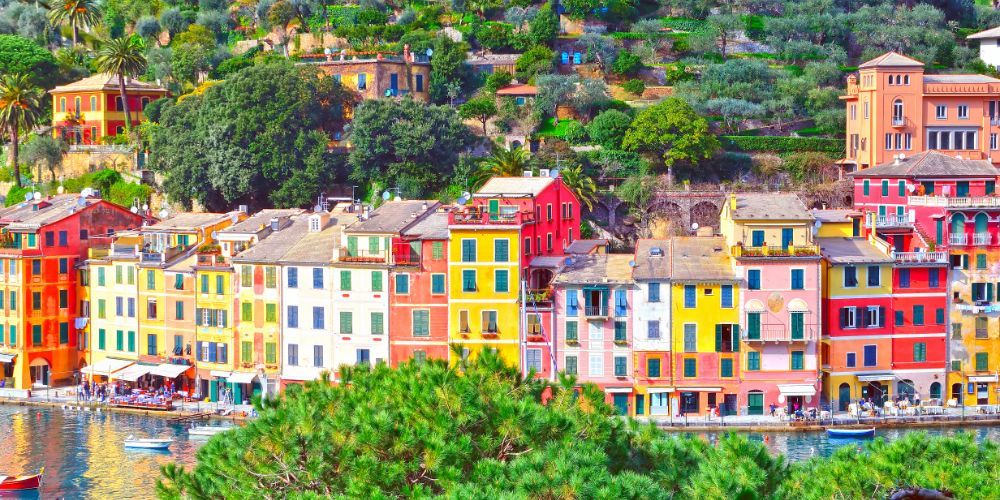
Before going to discover the 15 most colorful villages in Italy, you may wonder why Italy has so many of them (there are in fact well over fifteen) and who, in the first place, came up with the idea of using basically all the colors of the palette to paint houses.
Well, you will soon realize that in most cases these are coastal villages, located on the seashore or on the shore of large lakes. Painting the houses in bright colors, therefore, often responded to the need to make the villages more easily visible to fishermen returning from the sea, especially in winter and in case of fog. Today, technology and different lifestyles perhaps make this precaution superfluous, but Italy holds on to its colorful jewels, proud to once again offer a unique spectacle to its visitors.
15. Comacchio
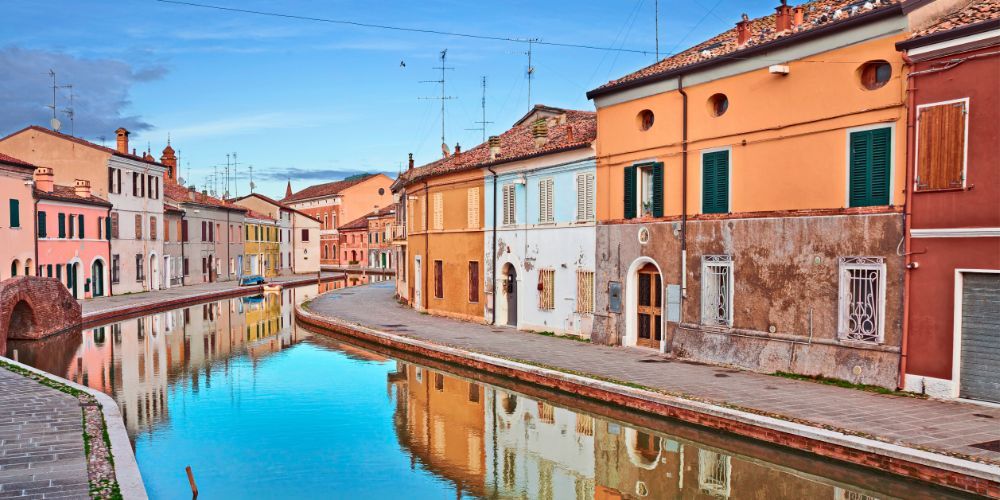
Let's begin our journey through the most colorful villages in Italy from Comacchio, known as the little Venice. The reason is easy to say, Comacchio is built on the water and between canals and bridges it really recalls the atmosphere of the lagoon city, plus the colors of its buildings make you think of those of another pearl of the Lagoon: Burano.
This village, however, is in Emilia-Romagna, near the mouth of the Po river and a beautiful stretch of coast known as the Sette Lidi di Comacchio, a much-loved and very lively summer destination.
The symbol of Comacchio is the famous Trepponti, a unique architectural complex made of three bridges nested one inside the other. Also worth seeing are the bridge Ponte degli Sbirri from which you can see Palazzo Bellini and the Antico Ospedale degli Infermi. The latter houses an important archaeological museum, the Museo Delta Antico, to which you should dedicate at least a few hours. Another famous monument is the Manifattura dei Marinati, the ancient factory still in operation where marinated eel, a local specialty, is prepared.
Comacchio is well connected to Ravenna with its UNESCO heritage art treasures, and to Ferrara, of which it is a province and is considered the heart of that natural wonder that is the Po Delta Park.
Discover Ravenna's beauty14. Borgo Parrini
Not only one of the most colorful villages in Italy, but also one of the most artistic. Borgo Parrini is located in eastern Sicily and has the bright colors of its land, combined with a touch of eccentricity that in many cases recalls the style of Gaudì. The village is really very small but majolica inserts, writings by well known authors and murals (the most famous one is dedicated to Frida Khalo) that decorate both the exterior and the interior of the low buildings, contribute to creating a whole that has no equal. It is no coincidence that this corner of Sicily is considered a small paradise for photographers and instagrammers.
Here they also make excellent bread that accompanies all the delicacies of Sicilian cuisine you can tase at the local restaurants.
Borgo Parrini is located less than fifty kilometers from Palermo, and is a hamlet of Partinico. It can therefore be ideal for a day trip from Palermo, to combine with all the other wonders that are found in the surroundings of the Sicilian capital, such as the natural beauties or the art treasures, for example the splendid Monreale.
Visit Monreale Cathedral12. Casamassima
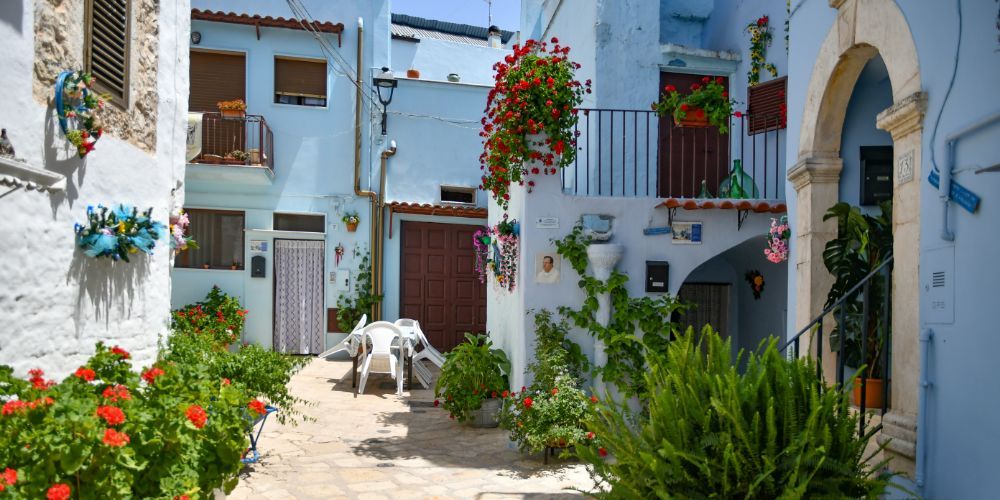
In the heart of Puglia, in the province of Bari, is Casamassima, the Blue Village. In its characteristic medieval historic center, in fact, the plasters in shades of blue and azure stand out and although once there were more of them, this village still retains its peculiarity and with it all its charm.
The Porta dell’Orologio near the main square gives access to the oldest part of the village, made up of narrow and often blind alleys, a characteristic of the place. For a small village, Casamassima has many churches to see, such as that of Santa Croce or the Monastery of Santa Chiara, not to mention the rural ones outside the center. Palazzo Ducale is the most important non-religious building, together with the Palazzo Municipale.
Casamassima is only thirteen kilometers from the capital of Puglia, so why not include a visit to one of the most colorful villages in Italy among the many things to do in Bari?
Rent a bike in Bari and explore the region13. Camogli
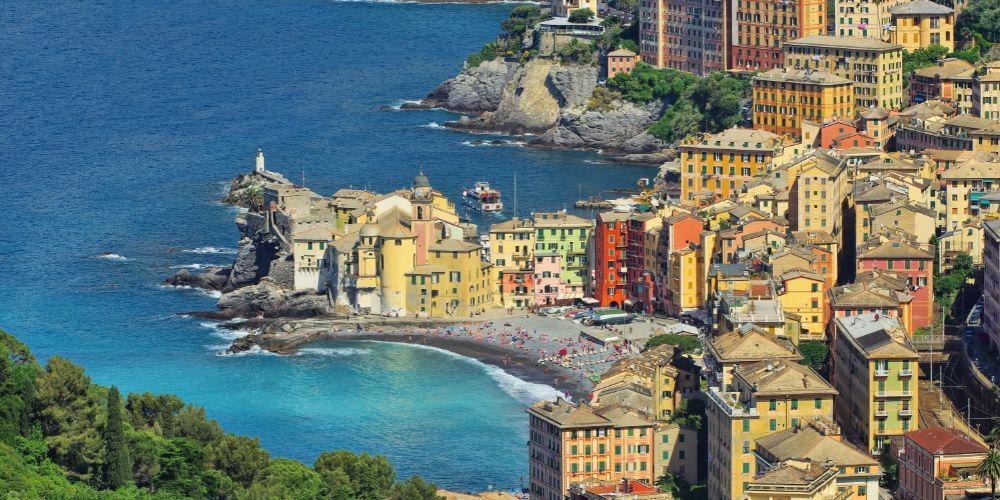
It seems that Liguria holds the record for the most colorful villages in Italy, and Camogli is just the first of a long list. The buildings painted in bright colors are a characteristic of the region but unlike many Ligurian villages, equally beautiful, Camogli is not located on the rocks overlooking the sea but rather on a beach in a cove of the Golfo Paradiso, province of Genoa.
Castel Dragone is its fortress, of which the tower and some ruins are visible, while the Museo del Mare tells the story of the village through the eyes of the local sailors and is truly very suggestive. The heart of the historic center is the Passeggiata Garibaldi, a promenade that leads to the Basilica of Santa Maria Assunta and is full of bars and shops.
Camogli's surroundings are also worth seeing. The Bay of San Fruttuoso is definitely worth a visit for its abbey and for the beach with blue sea, on the bottom of which there is an evocative submerged statue: the Christ of the Abyss. Not to be forgotten, also, just a few kilometers away there's the elegant Portofino, one of the most exclusive destinations in Italy.
Visit the abbey of San Fruttuoso11. Vipiteno
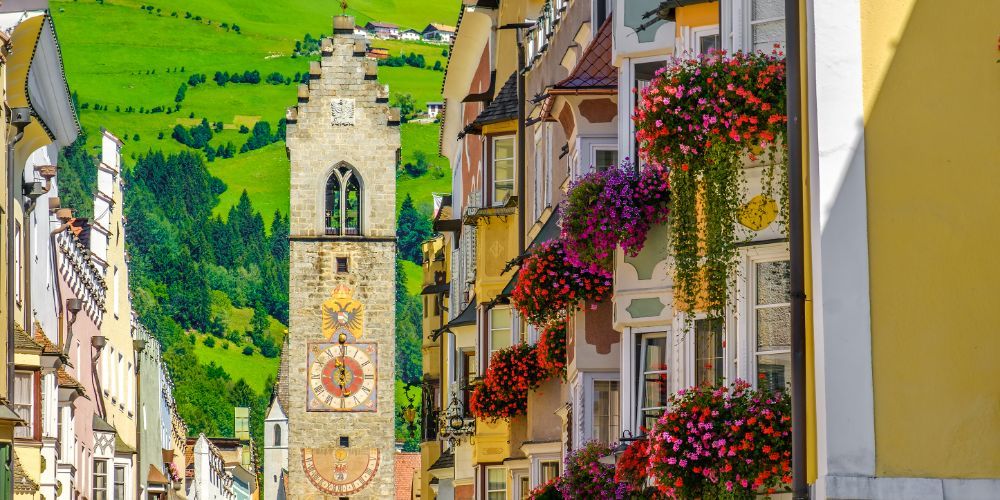
You have to temporarily leave the sea to visit another one of the most colorful villages in Italy, Vipiteno in the province of Bolzano in Trentino-Alto Adige. Here too, nature is spectacular, in fact the village is surrounded by the Breonie Alps, the Zillertal Alps and the Sarentine Alps. A true paradise for those who love the mountains, this is why Vipiteno is a very popular place both in summer and winter.
Its most iconic monument is the Torre delle Dodici, but in the highest city in Italy there is so much to do and see, starting for example with the museums, such as the one dedicated to the author of beautiful wooden altars Hans Multscher or the Civic Museum of the Teutonic Order. The churches of Nostra Signora delle Paludi and the Church of Santo Spirito are undoubtedly worth a visit, and if the colorful medieval historic center offers glimpses of rare beauty every season, Vipiteno at Christmas becomes nothing short of magical. Here, in fact, one of the most evocative Christmas markets in Italy takes place every year.
10. Castelsardo
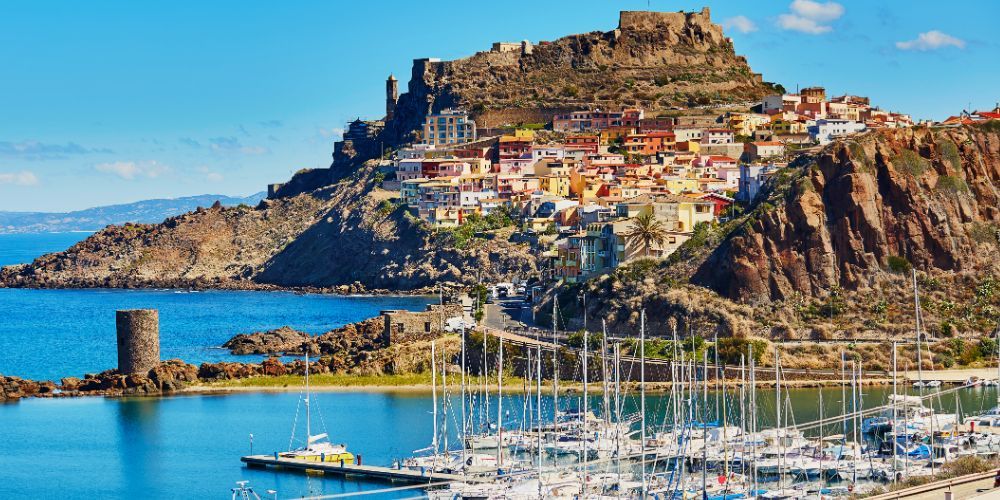
A fortress from which to admire wonderful views of the Gulf of Asinara, a picturesque and very popular tourist port, a Gothic cathedral clinging to the rock overlooking the sea and of course lots and lots of color. This is Castelsardo, a colorful Italian village in the province of Sassari, in the north of Sardinia.
The thousand-year-old fortress is known as Castello Doria or Bellavista, while the cathedral is that of Sant'Antonio Abate, but there is also much more to see and do in Castelsardo. Visit for example the bishop's palace with the library full of valuable volumes, or the church of Santa Maria delle Grazie where the Black Christ, protector of the village, is located, and the Tower of Frigiano, built by the Spanish to defend the port from the incursions of Saracen pirates. A short trip just outside the city is not to be missed to see an original rock formation that erosion has shaped into an elephant. The two cavities inside were used as a houses in the Neolithic.
The surroundings of Castelsardo are rich in archaeological sites where you can see nuraghi and suggestive cliffs that border a rocky coast with few beaches. A boat trip is recommended for spectacular views from the sea, including that of the colorful houses typical of the village!
9. Manarola
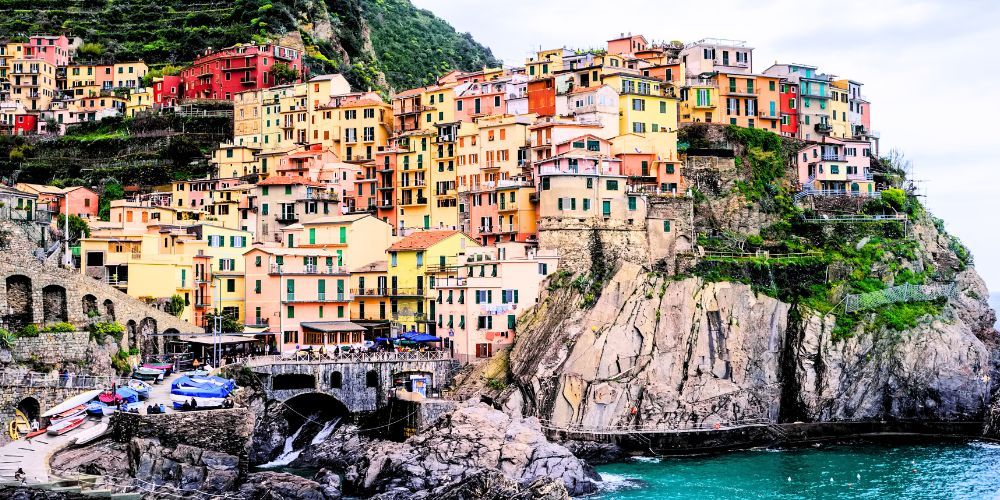
Nestled between the rugged rocks that make up the stretch of Ligurian coast known as Cinque Terre, Manarola is a small seaside village overlooking the sea that can be seen from afar for its multi-colored houses.
Its narrow and steep streets climb the hill and occasionally open up into wonderful panoramic views. Manarola is also known for being the arrival point of the famous Via dell'Amore, the Path of Love, a recently reopened path carved into the rock that offers enchanting and, of course, incredibly romantic views. The path is one-way, and it starts in Riomaggiore, the first of the Cinque Terre for those coming from nearby La Spezia.
There are many ways to reach the Cinque Terre, but due to its geographical conformation and its colors, Manarola becomes even more beautiful when seen from the sea. A boat trip is quite easy to organize, starting from La Spezia, and also also from the neighboring towns of Portovenere or Levanto.
8. Riomaggiore

If you visit Manarola, you just can't miss nearby Riomaggiore, the first of the Cinque Terre for those arriving from La Spezia. Here too you will find atmospheres suspended in time, unforgettable views and the typical colored houses, so steep on the sea they seem to defy gravity.
Riomaggiore is an excellent starting point if you want to walk on some of the best hiking trails in Liguria. From here you can walk not only on the Via dell'Amore to Manarola, you can also reach the other towns of the Cinque Terre via the Sentiero Azzurro and the Alta Via delle Cinque Terre, or perhaps walk the Sentiero dell'Infinito to Porto Venere.
If you prefer a more relaxing stay, stroll through the narrow streets of the village that develops around Piazza Vignaioli, just a few minutes from the train station, visit the ancient medieval castle and enjoy a well-deserved coffee break in the small and charming port. In Riomaggiore, you can also taste many of the delicacies of Ligurian cuisine, and there's more. You can even learn to prepare some of the cornerstones of Italian cuisine with your own hands by participating in a fun workshop.
Learn how to make fresh pasta and tiramisu7. Bosa
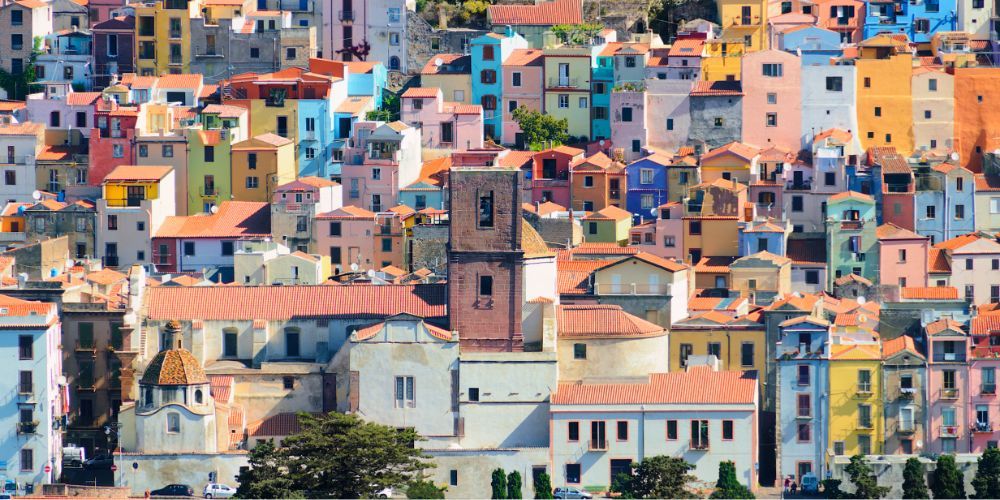
Among the most colorful villages in Italy, but also among the most beautiful, there is Bosa, on the north-western coast of Sardinia. In the province of Oristano, this picturesque village can be reached from the airport and the port of Alghero, another wonderful location in Sardinia.
Bosa is nestled in the bend of the Temo river, near the mouth and, therefore, the sea. Natural beauty is certainly not lacking, but what strikes you at first sight is the district of sa Costa with its thousand colors and the ancient Malaspina castle that has crowned it for about nine centuries. Inside its walls there is also one of the most important churches in the village, that of Nostra Signora de sos Regnos Altos.
Over time, Bosa has also become known for its tanneries, now a historical asset to which a museum is also dedicated. Here, craftsmanship and traditions are an integral part of the local culture. An example above all is the Karrasegare Osinku, the carnival that also exists in a summer version, lively and colorful just like the houses in the old town.
6. Porto Venere

Porto Venere is one of the many treasures of Liguria, halfway between the Cinque Terre and Tuscany. Located right at the western end of the Gulf of La Spezia, this ancient seaside village is typically Ligurian: clinging to the rocks overlooking the sea, with narrow streets and stairways that climb up the side of the hill, it is, needless to say, very colorful! Typical of Porto Venere, however, is its palazzata, a sort of barrier made of narrow and tall houses, which separates the sea from the rest of the village.
The center winds around the main street, via Capellini, where you can find shops, bars and restaurants. Among the main monuments is the Church of San Pietro, overlooking the sea, and the Doria Castle, which instead watches over the top of the hill. One of the many gems of Porto Venere is the Arpaia Cave, which is located below the castle and is also known as Lord Byron's cave because it seems that the famous poet particularly loved it, and came there to find solitude and inspiration.
Porto Venere is not only one of the most colorful villages in Italy, but it is also a National Park. From its port, sea excursions depart for the surrounding islands; the only one that can be visited is Palmaria, but the Cinque Terre are also not far away and a mini cruise is a must to admire this wonderful stretch of coast even from the sea.
Visit Porto Venere and Cinque Terre by boat5. Ponza

A journey through the most colorful villages in Italy cannot fail to stop at the island of Ponza, the queen of the Pontine Islands. We are in the Tyrrhenian Sea, a few kilometers away from the coasts of both Lazio and Campania, Ponza is therefore well connected to Rome and Naples.
It's the colors of the harbor, Porto Borbonico, that welcome visitors upon their arrival and accompany them on beautiful walks through the center that winds along Corso Pisacane, the main street where you can find shops, restaurants, bars and so on. Ponza is indeed also the heart of the nightlife of the Pontine Islands, especially in summer, but it also has a very long history that began at the time of the Phoenicians and that left numerous, important traces. The houses dug into the rock are a peculiarity of the island, absolutely worth visiting in the La Forna neighborhood.
Among the many colors of Ponza the most vivid is the blue of its sea. You can enjoy it on the most easily accessible beaches, those of Giancos, Cala Feola and Frontone, or by practicing one of the many water sports, such as diving, thanks to which you can see the spectacle of the Grotte di Pilato. This is a group of five artificial caves connected by underwater passages. They date back to the time of the emperor Augustus who chose Ponza to build one of his sumptuous villas, the remains of which are still visible.
4. Varenna

Lake Como, one of the largest and most beautiful in Italy, also perfect for unforgettable day trips from Milan, is particularly rich in small towns and picturesque villages to visit. Among them, in the province of Lecco, there is also one of the most colorful villages in Italy. It is Varenna, a place that seems to have come out of a fairy tale book, with almost thirteen centuries of history behind it.
In this fascinating and romantic place, a Lovers' Walk could not be missed. It's a short path overlooking the lake that leads to the small port, covered with a flowered pergola from which you can enjoy heart-rending views.
Among the colorful houses and the green of the hill on which Varenna is nestled, there are also some authentic architectural jewels. The Church of San Giorgio, for example, is a beautiful example of Lombard Gothic. It is located in the central square a few steps from another important monument, the 11th-century Church of San Giovanni Battista.
Of great value and beauty are also the historic villas, of which Lake Como is particularly rich. In its most colorful village there are Villa Cipressi, with terraces overlooking the lake and Villa Monastero, a former monastery with enchanting gardens.
Visit Lake Como by boat3. Portofino
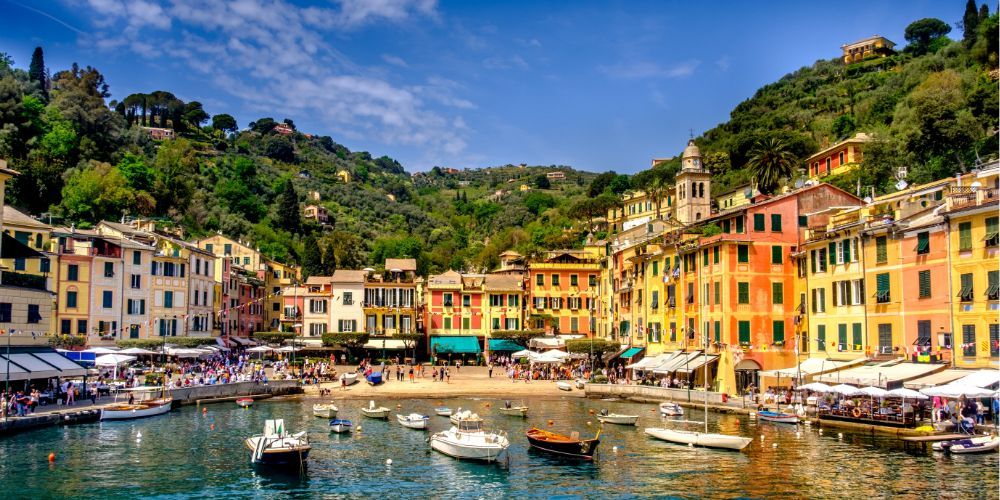
Portofino, one of the most colorful villages in Italy, is a fishing village on the Ligurian coast with a decidedly glamorous soul. Piazza Martiri dell'Olivetta, the main square, not only offers an extraordinary view to those arriving from the sea, thanks to the colors of its buildings, but it has also been the place where princesses, famous authors and the most iconic movie stars, from Clark Gable to Liz Taylor, have walked.
Today this square is also the center of the village's nightlife. There are many things to do in Portofino, however, even for those who are not passionate about nightlife. Trekking, for example, is a very popular activity. Portofino is in fact part of a Regional Natural Park with more than eighty kilometers of paths. A walk through the colorful old town is a must and then there are the monuments, such as the Church of San Martino, more than a thousand years old, or the Brown Castle that watches over the village from the top of a hill.
Portofino is located south of Genoa and in spring and summer it can be easily reached by ferry from Santa Margherita Ligure, Rapallo, Sestri Levante and Chiavari. The train station is Santa Margherita Ligure/Portofino.
2. Burano
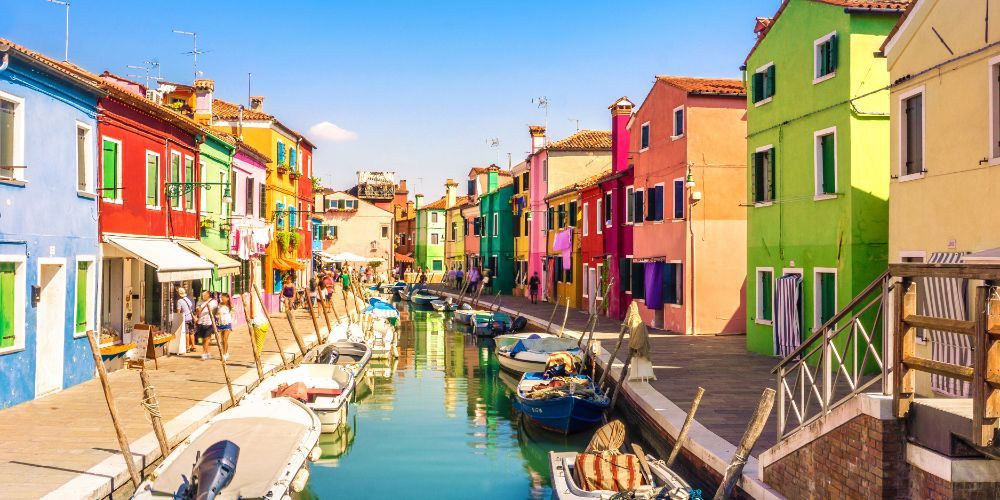
Burano is one of the three famous islands of the Venetian Lagoon and definitely the most colorful. Deep blue, bright yellow, shining green and then magenta, red, pink and the thousand colors of the flowers that adorn windows and balconies. It seems that Murano is not afraid to be noticed and the result is a truly unique ensemble.
Even the most famous building on the island, the House of Bepi Suà, is known for its colors because it is entirely decorated with colorful geometric shapes.
But there is also a lot to see in Burano. The lace making, for example, just as Murano's glass craft, has made it famous throughout the world and here you can find shops and workshops practically everywhere. Also worth visiting are thehisotrical monuments such as the Chapel of Santa Barbara and the adjacent Church of San Martino Vescovo where a canvas by Tiepolo is kept.
Burano also has the advantage of being easily reachable from Venice, to which, together with its sisters Murano and Torcello, it is connected with frequent ferries and hydrofoils. A tour of the Venice's three islands is an experience not to be missed, to get to know all three lagoon's gems.
Join the Venice's islands tour1. Most Colorful Villages in Italy: Procida
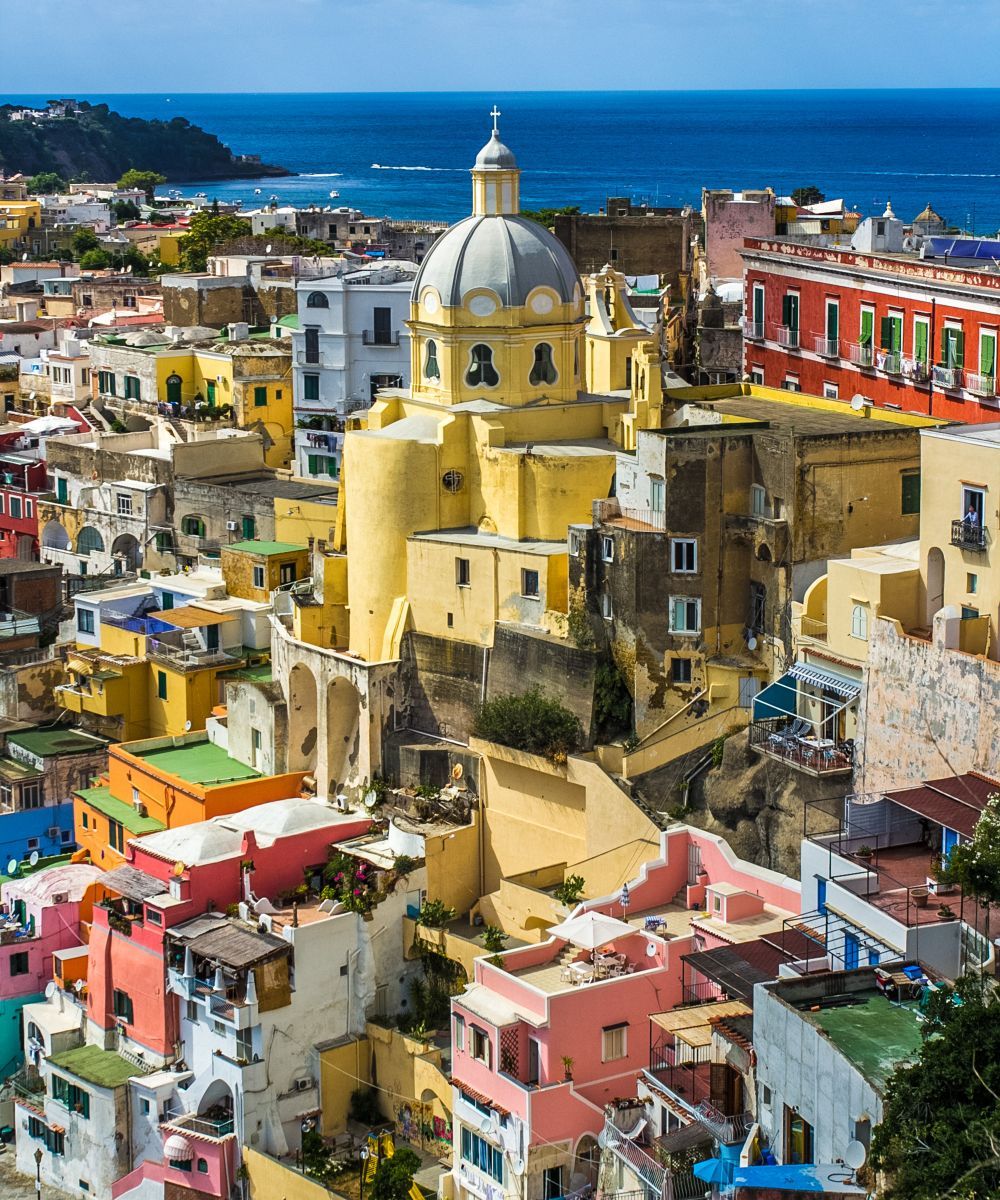
Not only one of the most beautiful ever, among the most colorful villages in Italy. The small island of Procida, one of the islands in the Gulf of Naples, was the birthplace of the novel "Gabrielle" by Alphonse de Lamantine, it was "Arturo's Island", where Elsa Morante set her famous novel in 1957, more recently it was also a cinematographic set for the awards winning movie "Il Postino" with Philippe Noiret in 1996 and in 2022 Procida became the Capital of Culture in Italy.
A place extraordinarily rich in history, culture and charm, with colorful houses that are reflected in the blue sea, but also many monuments such as Palazzo D'Avalos, in the beautiful ancient heart of Procida, Terra Murata, or the Sanctuary of Maria delle Grazie. There is no shortage of beaches, of course, such as Ciracchiaio or Chiaiolella. Connected to Procida by a bridge, there is also the small island of Vivara, a protected marine oasis.
Here life is still simple and quiet and despite all that it can offer its visitors, the island is still in a certain sense a hidden gem, proud of its authenticity and perfect for lovers of slow tourism.
Visit Procida from NaplesAbout the author
Written on 09/10/2024

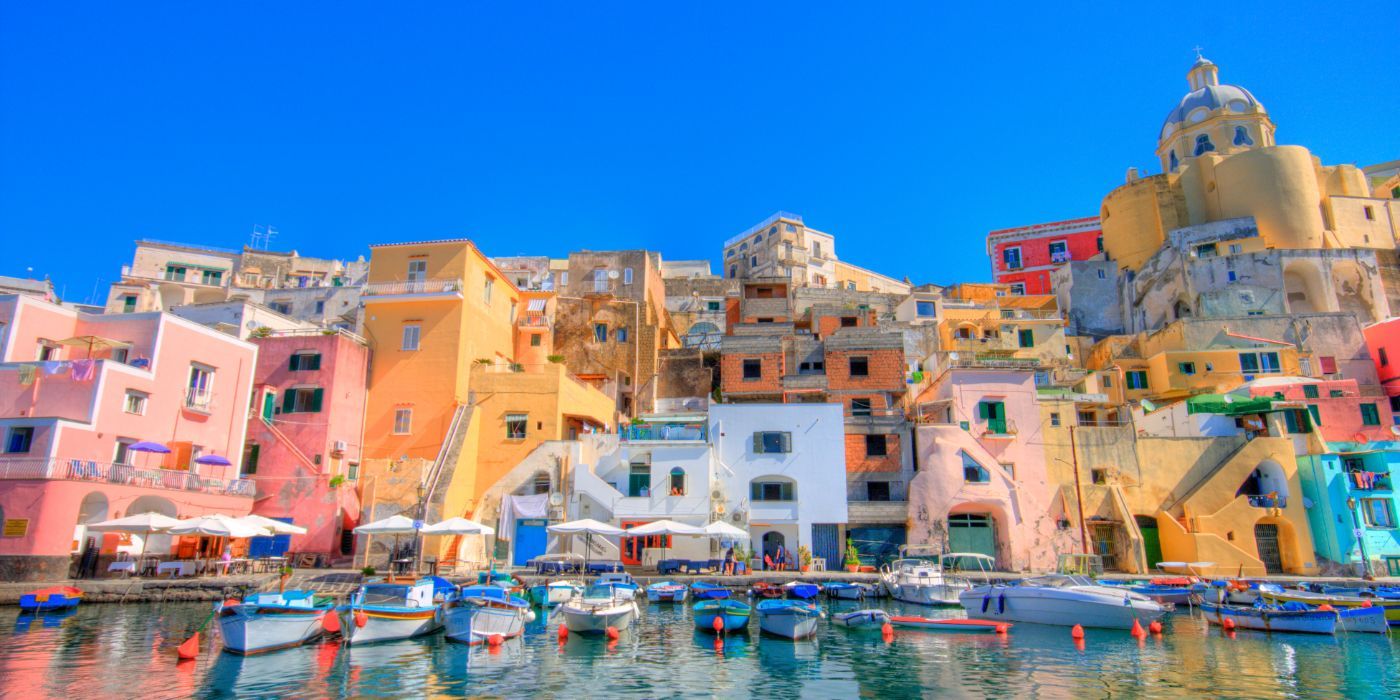

Paola Cirino
Do you already know the most colorful villages in Italy? Set off on a journey to discover the fifteen most cheerful villages to visit and photograph